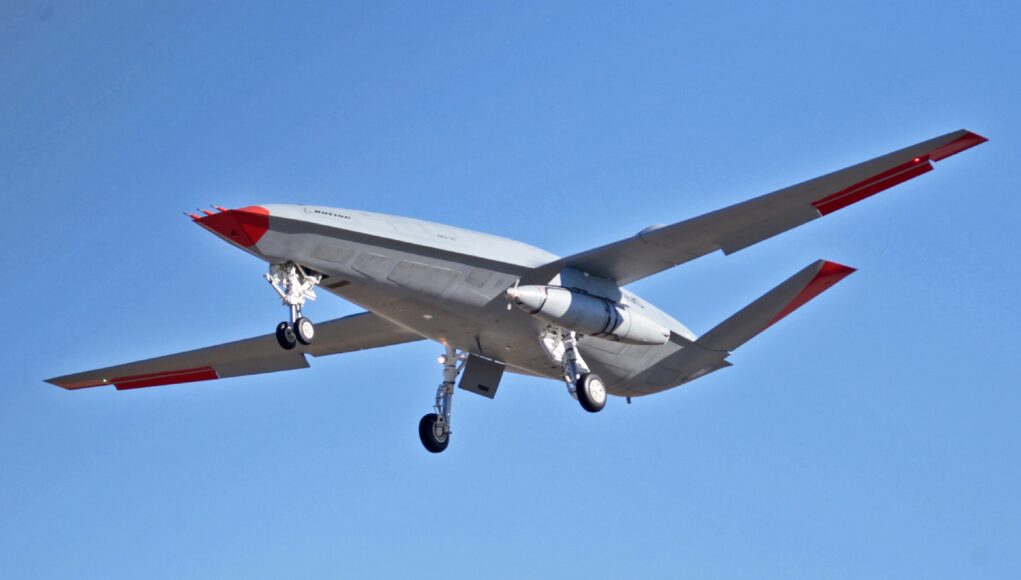Boeing and the U.S. Navy have for the first time flown the MQ-25 T1 test asset with an aerial refueling store (ARS), a significant milestone informing development of the unmanned aerial refueler.
The successful 2.5-hour flight with the Cobham ARS – the same ARS currently used by F/A-18s for air-to-air refueling – was designed to test the aircraft’s aerodynamics with the ARS mounted under the wing.
The flight was conducted by Boeing test pilots operating from a ground control station at MidAmerica St. Louis Airport in Mascoutah, Ill.
“Having a test asset flying with an ARS gets us one big step closer in our evaluation of how MQ-25 will fulfill its primary mission in the fleet – aerial refueling,” said Capt. Chad Reed, the U.S. Navy’s Unmanned Carrier Aviation program manager.
“T1 will continue to yield valuable early insights as we begin flying with F/A-18s and conduct deck handling testing aboard a carrier.”
Boeing say that future flights will continue to test the aerodynamics of the aircraft and the ARS at various points of the flight envelope, eventually progressing to extension and retraction of the hose and drogue used for refueling.
“To see T1 fly with the hardware and software that makes MQ-25 an aerial refueler this early in the program is a visible reminder of the capability we’re bringing to the carrier deck,” said Dave Bujold, Boeing’s MQ-25 program director.
“We’re ensuring the ARS and the software operating it will be ready to help MQ-25 extend the range of the carrier air wing.”
Earlier this year the Navy exercised an option for three additional MQ-25 air vehicles, bringing the total aircraft Boeing is initially producing to seven.
The U.S. Navy intends to procure more than 70 aircraft, which will assume the tanking role currently performed by F/A-18s, allowing for better use of the combat strike fighters.














“Ars”
Made me chuckle as well.
Now all we need is to add a system with the acronym Feck.
Fueling Equipment Carrier Kit
Great kit and good that Cobham involved. Certainly looking like the future.
Wouldn’t get off the Queen Elizabeth fully laden if indeed empty. Anyone any further info on AR developments for the carriers without revisiting the ‘can we afford the Osprey’ question?
With the exception of Crowsnest this has surely got to be the most pressing issue for carrier group effectiveness.
Lol. I think you are right but I also think the most pressing Issue is sorting all the Leeks/leaks and getting a heck of a lot more F35B’s to grace their Decks. So far we’ve only managed 5 ?
You’re not wrong Captain. Snagging list and a proper compliment of aircraft aside surely got to be high up on the list.
Fully agree with this. We need to get a lot more of our own F35Bs onto the ships, not just relying on the USMC planes to bolster the ranks.
If we can get at least 24 of our own F35s onto the ship, then we can start worrying about A2A refuelling to extend their range.
Is Rear Gunner still on here ?
Wonder who watched the Final Acceptance Test for the Aerial Refueling Store?..
This will be being followed closely by all corners of the globe I’d imagine. Certainly gaining traction as the extra test aircraft are now on order.
Impressive to watch but wouldn’t want to be anywhere near when they start carrier trials will a full fuel load !…
Guess a few important Navy/Boeing representatives at St.Louis watching on a screen, but doesn’t actually say where the physical flight was?..
I just get the impression that this thing will struggle cutting through bad weather. Will be interesting to see how it goes!
Hi can anyone help…….
Did we have in flight refuelling for the Harriers on the previous carriers
Thank you Ian
They were equipped for in flight fuelling but only from tankers. Unlike most previous RN jets dont think they were equipped for ‘buddy buddy’ refuelling, relying more on the drop tanks for long sorties (many simply dropped into the sea for landings).
Phantom, Sea Vixen and especially the Buccaneers performed well as ‘buddy tankers’.
Thank you AV…….how do the USN refuel is that tanker or buddy
They’re pretty much equipped for both.
More help needed…… when our aircraft carries are operating in the Med would some of our tanker fleet be able to refuel our F35s flying from Cyprus and Gibraltar
Or could we use NATO bases
Thanks in advance…… Ian
Both if necessary. The real issue is for long range strike into protected airspace. As you can appreciate a tanker isn’t one of the stealthiest of assets. Couple this with reasonable (but shorter) legs on the F35b you’re putting your carrier and complete strike group unnecessarily close to the action.
Hence the real beauty of a stealthy drone tanker that accompanies the fleet and the strike aircraft.
In the case of the US Navy would keep the carrier strike group further away from hostile assets whilst offering a quantum leap in strike range for the aircraft.
Theoretically with daisy chained and buddy buddy refuelling you could put a few strike aircraft anywhere you needed.